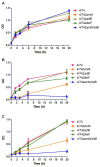Investigation of the Role of Genes Encoding Zinc Exporters zntA, zitB, and fieF during Salmonella Typhimurium Infection
- PMID: 29375521
- PMCID: PMC5768658
- DOI: 10.3389/fmicb.2017.02656
Investigation of the Role of Genes Encoding Zinc Exporters zntA, zitB, and fieF during Salmonella Typhimurium Infection
Abstract
The transition metal zinc is involved in crucial biological processes in all living organisms and is essential for survival of Salmonella in the host. However, little is known about the role of genes encoding zinc efflux transporters during Salmonella infection. In this study, we constructed deletion mutants for genes encoding zinc exporters (zntA, zitB, and fieF) in the wild-type (WT) strain Salmonella enterica serovar Typhimurium (S. Typhimurium) 4/74. The mutants 4/74ΔzntA and 4/74ΔzntA/zitB exhibited a dramatic growth delay and abrogated growth ability, respectively, in Luria Bertani medium supplemented with 0.25 mM ZnCl2 or 1.5 mM CuSO4 compared to the WT strain. In order to investigate the role of genes encoding zinc exporters on survival of S. Typhimurium inside cells, amoeba and macrophage infection models were used. No significant differences in uptake or survival were detected for any of the mutants compared to the WT during infection of amoebae. In natural resistance-associated macrophage protein 1 (Nramp1)-negative J774.1 murine macrophages, significantly higher bacterial counts were observed for the mutant strains 4/74ΔzntA and 4/74ΔzntA/zitB compared to the WT at 4 h post-infection although the fold net replication was similar between all the strains. All four tested mutants (4/74ΔzntA, 4/74ΔzitB, 4/74ΔfieF, and 4/74ΔzntA/zitB) showed enhanced intracellular survival capacity within the modified Nramp1-positive murine RAW264.7 macrophages at 20 h post-infection. The fold net replication was also significantly higher for 4/74ΔzntA, 4/74ΔzitB, and 4/74ΔzntA/zitB mutants compared to the WT. Intriguingly, the ability to survive and cause infection was significantly impaired in all the three mutants tested (4/74ΔzntA, 4/74ΔzitB, and 4/74ΔzntA/zitB) in C3H/HeN mice, particularly the double mutant 4/74ΔzntA/zitB was severely attenuated compared to the WT in all the three organs analyzed. These findings suggest that these genes encoding zinc exporters, especially zntA, contribute to the resistance of S. Typhimurium to zinc and copper stresses during infection.
Keywords: S. Typhimurium; amoebae; infection; macrophages; mice; zinc export.
Figures




Similar articles
-
MntP and YiiP Contribute to Manganese Efflux in Salmonella enterica Serovar Typhimurium under Conditions of Manganese Overload and Nitrosative Stress.Microbiol Spectr. 2022 Feb 23;10(1):e0131621. doi: 10.1128/spectrum.01316-21. Epub 2022 Jan 12. Microbiol Spectr. 2022. PMID: 35019706 Free PMC article.
-
Nitric Oxide Disrupts Zinc Homeostasis in Salmonella enterica Serovar Typhimurium.mBio. 2018 Aug 14;9(4):e01040-18. doi: 10.1128/mBio.01040-18. mBio. 2018. PMID: 30108168 Free PMC article.
-
ZntR-mediated transcription of zntA responds to nanomolar intracellular free zinc.J Inorg Biochem. 2012 Jun;111:173-81. doi: 10.1016/j.jinorgbio.2012.02.008. Epub 2012 Feb 22. J Inorg Biochem. 2012. PMID: 22459916 Free PMC article.
-
The two murein lipoproteins of Salmonella enterica serovar Typhimurium contribute to the virulence of the organism.Infect Immun. 2004 Jul;72(7):3987-4003. doi: 10.1128/IAI.72.7.3987-4003.2004. Infect Immun. 2004. PMID: 15213144 Free PMC article.
-
Murein lipoprotein is a critical outer membrane component involved in Salmonella enterica serovar typhimurium systemic infection.Infect Immun. 2005 Feb;73(2):1081-96. doi: 10.1128/IAI.73.2.1081-1096.2005. Infect Immun. 2005. PMID: 15664952 Free PMC article.
Cited by
-
MntP and YiiP Contribute to Manganese Efflux in Salmonella enterica Serovar Typhimurium under Conditions of Manganese Overload and Nitrosative Stress.Microbiol Spectr. 2022 Feb 23;10(1):e0131621. doi: 10.1128/spectrum.01316-21. Epub 2022 Jan 12. Microbiol Spectr. 2022. PMID: 35019706 Free PMC article.
-
Interaction Differences of the Avian Host-Specific Salmonella enterica Serovar Gallinarum, the Host-Generalist S. Typhimurium, and the Cattle Host-Adapted S. Dublin with Chicken Primary Macrophage.Infect Immun. 2019 Nov 18;87(12):e00552-19. doi: 10.1128/IAI.00552-19. Print 2019 Dec. Infect Immun. 2019. PMID: 31548317 Free PMC article.
-
Impairment of the Zn/Cd detoxification systems affects the ability of Salmonella to colonize Arabidopsis thaliana.Front Microbiol. 2022 Aug 22;13:975725. doi: 10.3389/fmicb.2022.975725. eCollection 2022. Front Microbiol. 2022. PMID: 36071967 Free PMC article.
-
Manganese Transporter Proteins in Salmonella enterica serovar Typhimurium.J Microbiol. 2023 Mar;61(3):289-296. doi: 10.1007/s12275-023-00027-7. Epub 2023 Mar 2. J Microbiol. 2023. PMID: 36862278 Review.
-
Zinc in Human Health and Infectious Diseases.Biomolecules. 2022 Nov 24;12(12):1748. doi: 10.3390/biom12121748. Biomolecules. 2022. PMID: 36551176 Free PMC article. Review.
References
-
- Ammendola S., Pasquali P., Pistoia C., Petrucci P., Petrarca P., Rotilio G., et al. (2007). High-affinity Zn2+ uptake system ZnuABC is required for bacterial zinc homeostasis in intracellular environments and contributes to the virulence of Salmonella enterica. Infect. Immun. 75 5867–5876. 10.1128/IAI.00559-07 - DOI - PMC - PubMed
LinkOut - more resources
Full Text Sources
Other Literature Sources
Research Materials

